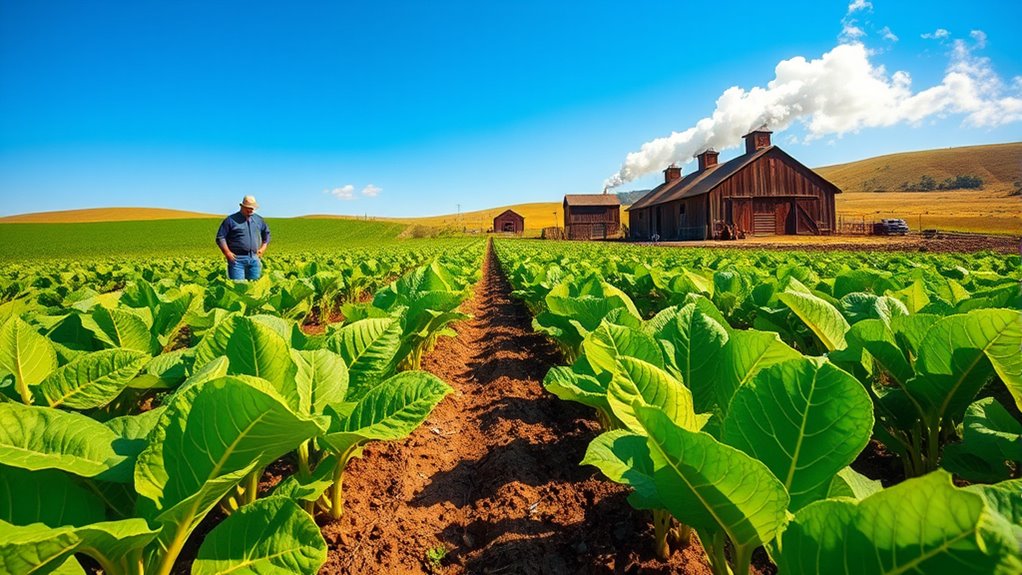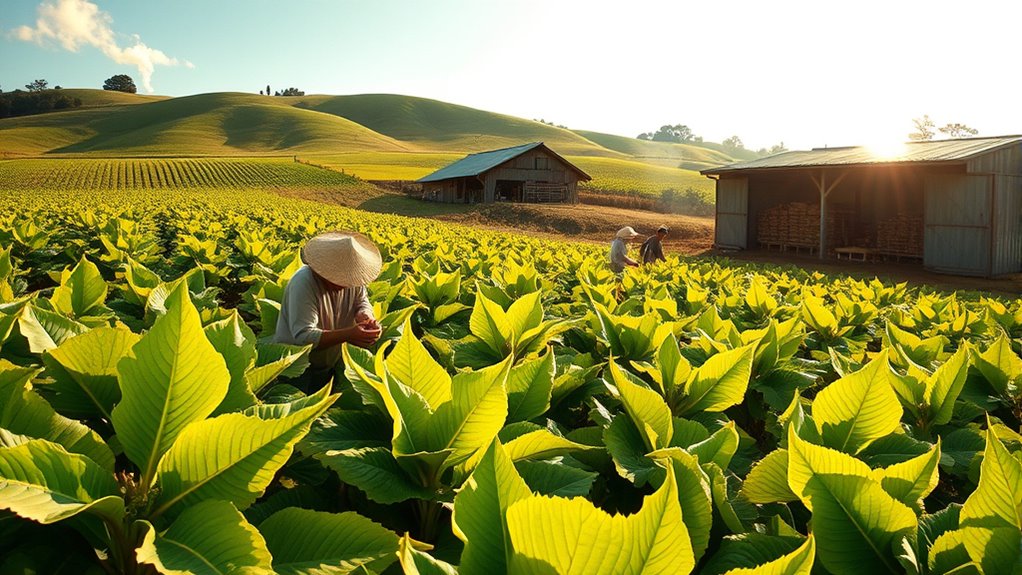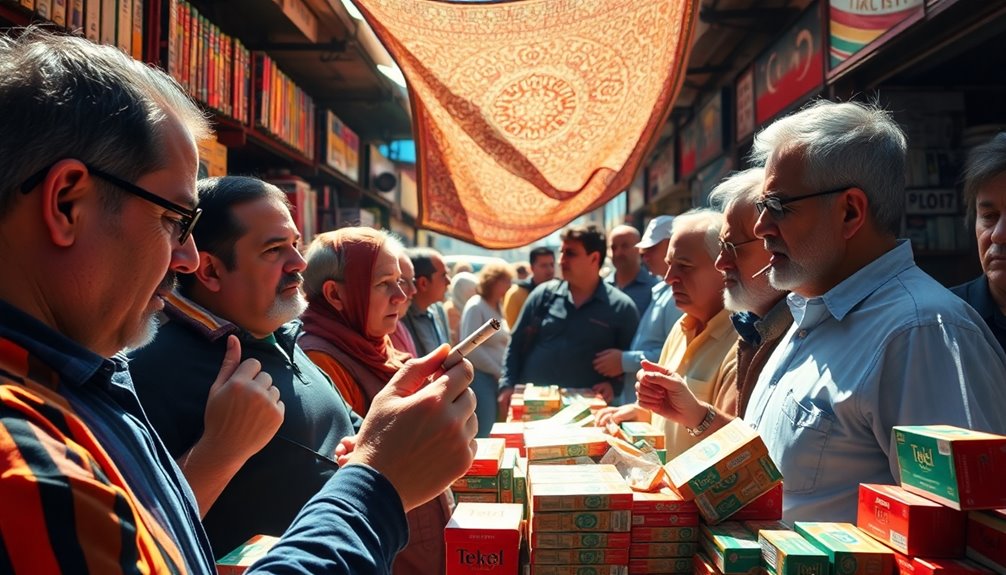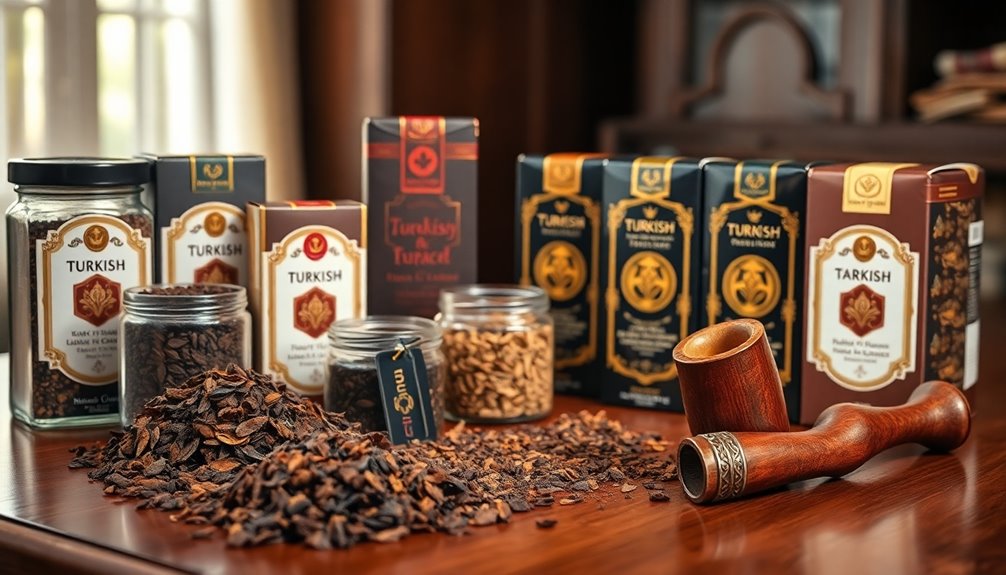To produce premium tobacco, you need to carefully grow your plants and harvest at just the right time when leaves reach ideal maturity and color. Handling leaves gently during harvest prevents damage, and immediate, proper curing—using methods like air, fire, or flue curing—preserves their flavor and aroma. Monitoring conditions like temperature and humidity during curing guarantees even drying and prevents mold. Mastering these steps open the rich, nuanced qualities that make high-quality tobacco sought after; keep exploring to learn the full process.
Key Takeaways
- Selecting the right seed and harvesting leaves at optimal maturity ensures quality and flavor.
- Gentle handling during harvesting prevents damage and maintains leaf integrity for better curing.
- Different curing methods like air, fire, flue, or sun are chosen based on desired tobacco characteristics.
- Monitoring temperature, humidity, and airflow is crucial to achieve even drying and prevent mold.
- Proper fermentation after curing enhances flavor, aroma, and overall quality of premium tobacco.

Tobacco growing and curing are vital steps in producing high-quality tobacco, requiring careful attention at each stage. When it comes to tobacco leaf harvesting, timing is everything. You need to pick the leaves at just the right moment—usually when they reach ideal maturity and color—to guarantee the best flavor and nicotine content. If you harvest too early, the leaves might be too green and lack richness; if you wait too long, they could become overly ripe and lose their desired qualities. As you pick the leaves, handle them gently to avoid tearing or bruising, which can compromise the curing process and the final product’s quality.
Once harvested, the leaves immediately enter the curing process. This stage is vital because it transforms fresh, green leaves into the aromatic, flavorful tobacco you’re familiar with. There are several curing process techniques you might use, depending on the type of tobacco and the desired characteristics. Air curing involves hanging the leaves in well-ventilated barns for several weeks, allowing natural air to slowly dry the leaves. This method is ideal for tobaccos used in cigarettes and cigars, as it preserves delicate flavors and reduces harshness. Fire curing, on the other hand, involves hanging the leaves near smoldering fires, imparting a smoky aroma and a more robust flavor—common in pipe and chewing tobaccos. Flue curing uses heated air circulated through a controlled environment, quickly drying the leaves and producing a milder taste, often used for cigarette tobacco. Lastly, sun curing entails laying the leaves out in the sun, a traditional method that can add unique flavor notes.
Throughout the curing process, you need to monitor temperature, humidity, and airflow meticulously. Proper ventilation prevents mold and over-drying, which can lead to harshness or bitterness. You might also need to turn the leaves periodically to guarantee even drying and prevent mold buildup. As the curing progresses, the leaves change in color from bright green to shades of yellow, brown, or tan, signaling that they’re ready for the next stage of processing. Additionally, understanding the importance of proper fermentation can further enhance the tobacco’s flavor profile and overall quality.
Frequently Asked Questions
What Are the Environmental Impacts of Tobacco Cultivation?
Tobacco cultivation impacts the environment considerably. You should know it causes environmental pollution through pesticide and fertilizer runoff, which harms nearby ecosystems. Water consumption is high, often draining local water sources and affecting other crops and communities. These practices can lead to soil degradation and loss of biodiversity. Being aware of these impacts helps you understand the importance of sustainable farming practices to reduce the ecological footprint of tobacco growing.
How Do Different Curing Methods Affect Tobacco Flavor?
You’re in for a treat, as curing techniques can truly make or break tobacco flavor. Different methods, like air curing or fire curing, markedly impact flavor preservation, each adding unique nuances. For example, air curing brings out smooth, mellow notes, while fire curing imparts smoky richness. Your choice of curing method directly influences the tobacco’s taste profile, making it essential to select the right technique for the desired flavor.
Are There Sustainable Practices in Premium Tobacco Farming?
You’ll find that sustainable practices in premium tobacco farming focus on eco-friendly farming methods, like using organic fertilizers and minimizing chemical use. Water conservation techniques are also key, such as drip irrigation and rainwater harvesting, which reduce water waste. These practices help protect the environment while maintaining high-quality tobacco. By prioritizing eco-friendly farming, growers guarantee a more sustainable future for premium tobacco production.
What Role Do Pests Play in Tobacco Crop Quality?
Pests critically impact your tobacco crop quality, as they can damage leaves and hinder plant growth. Effective pest management is essential to minimize pest impact, ensuring healthy, premium leaves. When pests are uncontrolled, they cause defects and reduce overall quality, which affects the final product. You need to monitor pests regularly and use sustainable practices to protect your crop without harming the environment. Proper pest management keeps your tobacco healthy and enhances its quality.
How Is Soil Health Maintained During Intensive Tobacco Farming?
You maintain soil health during intensive tobacco farming by practicing soil enrichment through organic matter addition and implementing crop rotation. Crop rotation helps prevent soil depletion and reduces pest buildup, keeping your soil fertile and productive. You also add compost and organic fertilizers to enhance nutrient levels. These methods guarantee healthy soil, support robust crop growth, and promote sustainable farming practices, ultimately leading to high-quality tobacco.
Conclusion
As you savor that smooth, premium smoke, remember the journey it took—from lush green fields to careful curing. Imagine the vibrant leaves basking in sunlight, then gently hanging in cool, quiet barns. It’s a stark contrast, yet both are essential: the lively growth that awakens the senses and the patient curing that transforms it into perfection. So, next time you indulge, appreciate the delicate balance between nature’s bounty and human craftsmanship.










